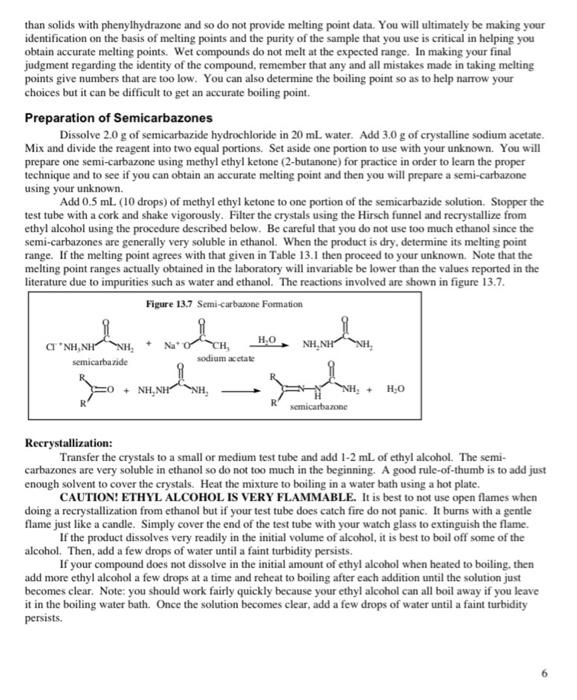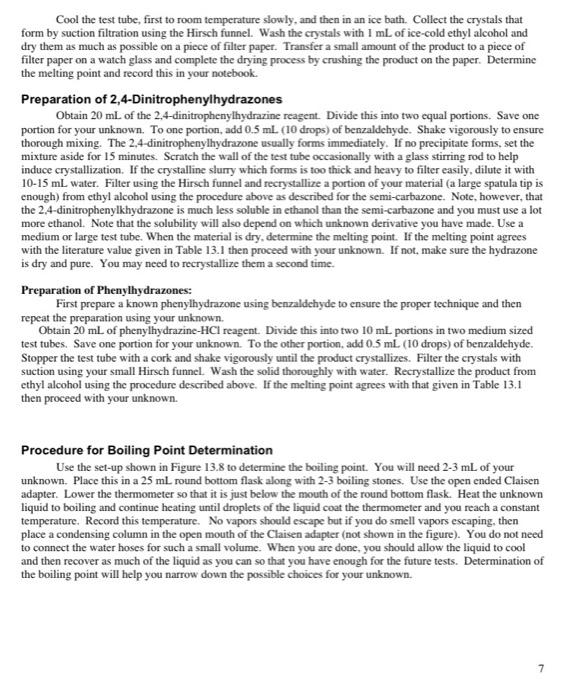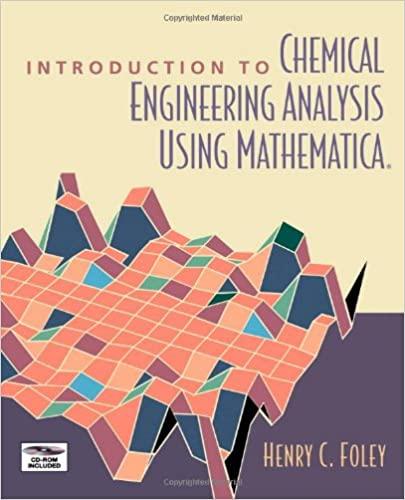6. Reaction of semicarbazide with carbonyl group is shown in Fig 13.7. Semicarbazide has three amino nitrogens. Explain why the other two nitrogens don't react at the carbonyl carbon. 3 pt) 7 DNPH derivative of an unknown gave a melting naint of 155 500 Fynlain what teste van wand Figure 136 ledoform Reaction HO . H OH OH H1 HCI Indofarm yellow solid Procedure: Dissolve 4 drops of a methyl ketone in 1 mL of methanol in a large test tube. Add 1.0 mL of a 10% NaOH solution. Then add KIA, solution drop-wise with shaking until a slight excess of l, remains as indicated by the yellowish or pale brown color of iodine. If 2 mL or more of the KI/, reagent was used, then fill the test tube with water and allow it to stand for 15 minutes. A yellow precipitate indicates a positive test. If less than 2 ml of the KI/1, reagent was used, then it may be necessary to heat the reaction for a short time (2-3 minutes) at 60 C in a water bath. If all of the color disappears on heating, then add a few more drops of the KI/1, reagent until the color persists. Fill the test tube with water and allow it to stand for 15 minutes. A yellow precipitate indicates a positive test for a methyl ketone but a positive test is also produced by acetaldehyde, CH CHO, and ethanol, which is oxidized by the I, to acetaldehyde. Part II Identification of Carbonyl Unknown: You will now identify a carbonyl unknown using the tests above and by preparing derivatives of your unknown and taking the melting points. Your unknown will be one of those carbonyls listed in Table 13.1 at the end of this experiment. By comparing the melting points of your unknown derivatives to known values reported in the literature (see Table 13.1) you can identify exactly your unknown compound. You can confirm this identification by taking the IR and matching it with one of the spectra given in Appendix 13.1. Procedure: Get a sample of an unknown aldehyde or ketone from the teaching assistant. Your first task is to determine whether or not it is an aldehyde or a ketone. Perform the Chromic Acid Test, the Tollen's Test, and the lodoform Test. Based on these results you should be able to determine whether your compound is one of the aldehydes or ketones and whether you have the methyl ketone (CH-C(O) group. You will now prepare at least two derivatives of the unknown in order to determine its exact identity Looking at the list in Table 13.1 you see that there are three possible derivatives that you can use. Begin by preparing the 2.4-dinitrophenylhydrazone and the semicarbazone. If, however, these two derivatives do not give you a clear answer, then you will have to prepare the phenylhydrazone derivative. It is recommended that you prepare all three derivatives so as to give you extra information in helping you make your final identification. But note from looking at Table 13.1 you can see that some of the derivatives form oils rather 5 than solids with phenylhydrazone and so do not provide melting point data. You will ultimately be making your identification on the basis of melting points and the purity of the sample that you use is critical in helping you obtain accurate melting points. Wet compounds do not melt at the expected range. In making your final judgment regarding the identity of the compound, remember that any and all mistakes made in taking melting points give numbers that are too low. You can also determine the boiling point so as to help narrow your choices but it can be difficult to get an accurate boiling point Preparation of Semicarbazones Dissolve 2.0 g of semicarbazide hydrochloride in 20 mL water. Add 3.0 g of crystalline sodium acetate. Mix and divide the reagent into two equal portions. Set aside one portion to use with your unknown. You will prepare one semi-carbazone using methyl ethyl ketone (2-butanone) for practice in order to learn the proper technique and to see if you can obtain an accurate melting point and then you will prepare a semi-carbazone using your unknown. Add 0.5 mL. (10 drops) of methyl ethyl ketone to one portion of the semicarbazide solution. Stopper the test tube with a cork and shake vigorously. Filter the crystals using the Hirsch funnel and recrystallize from ethyl alcohol using the procedure described below. Be careful that you do not use too much ethanol since the semi-carbazones are generally very soluble in ethanol. When the product is dry, determine its melting point range. If the melting point agrees with that given in Table 13.1 then proceed to your unknown. Note that the melting point ranges actually obtained in the laboratory will invariable be lower than the values reported in the literature due to impurities such as water and ethanol. The reactions involved are shown in figure 13.7. Figure 13.7 Semi-carbuone Formation HO Na NH, NH NH, a NHNH semicarbazide sodium acetate + NH, NH Bay H.O semicarbazone Recrystallization: Transfer the crystals to a small or medium test tube and add 1-2 mL of ethyl alcohol. The semi- carbazones are very soluble in ethanol so do not too much in the beginning. A good rule-of-thumb is to add just enough solvent to cover the crystals. Heat the mixture to boiling in a water bath using a hot plate. CAUTION! ETHYL ALCOHOL IS VERY FLAMMABLE. It is best to not use open flames when doing a recrystallization from ethanol but if your test tube does catch fire do not panic. It burns with a gentle flame just like a candle. Simply cover the end of the test tube with your watch glass to extinguish the flame. If the product dissolves very readily in the initial volume of alcohol, it is best to boil off some of the alcohol. Then add a few drops of water until a faint turbidity persists. If your compound does not dissolve in the initial amount of ethyl alcohol when heated to boiling, then add more ethyl alcohol a few drops at a time and reheat to boiling after each addition until the solution just becomes clear. Note: you should work fairly quickly because your ethyl alcohol can all boil away if you leave it in the boiling water bath. Once the solution becomes clear, add a few drops of water until a faint turbidity persists. Cool the test tube, first to room temperature slowly, and then in an ice bath. Collect the crystals that form by suction filtration using the Hirsch funnel. Wash the crystals with 1 mL of ice-cold ethyl alcohol and dry them as much as possible on a piece of filter paper. Transfer a small amount of the product to a piece of filter paper on a watch glass and complete the drying process by crushing the product on the paper. Determine the melting point and record this in your notebook. Preparation of 2,4-Dinitrophenylhydrazones Obtain 20 mL of the 24-dinitrophenylhydrazine reagent. Divide this into two equal portions. Save one portion for your unknown. To one portion, add 0.5 mL (10 drops) of benzaldehyde. Shake vigorously to ensure thorough mixing. The 2.4-dinitrophenylhydrazone usually forms immediately. If no precipitate forms, set the mixture aside for 15 minutes. Scratch the wall of the test tube occasionally with a glass stirring rod to help induce crystallization. If the crystalline slurry which forms is too thick and heavy to filter easily, dilute it with 10-15 mL water. Filter using the Hirsch funnel and recrystallize a portion of your material (a large spatula tip is enough) from ethyl alcohol using the procedure above as described for the semi-carbazone. Note, however, that the 2.4-dinitrophenylkhydrazone is much less soluble in ethanol than the semi-carbazone and you must use a lot more ethanol. Note that the solubility will also depend on which unknown derivative you have made. Use a medium or large test tube. When the material is dry, determine the melting point. If the melting point agrees with the literature value given in Table 13.1 then proceed with your unknown. If not, make sure the hydrazone is dry and pure. You may need to recrystallize them a second time. Preparation of Phenylhydrazones: First prepare a known phenylhydrazone using benzaldehyde to ensure the proper technique and then repeat the preparation using your unknown. Obtain 20 mL of phenylhydrazine-HCl reagent. Divide this into two 10 mL portions in two medium sized test tubes. Save one portion for your unknown. To the other portion, add 0.5 mL (10 drops) of benzaldehyde. Stopper the test tube with a cork and shake vigorously until the product crystallizes. Filter the crystals with suction using your small Hirsch funnel Wash the solid thoroughly with water. Recrystallize the product from ethyl alcohol using the procedure described above. If the melting point agrees with that given in Table 13.1 then proceed with your unknown. Procedure for Boiling Point Determination Use the set-up shown in Figure 13.8 to determine the boiling point. You will need 2-3 mL of your unknown. Place this in a 25 ml round bottom flask along with 2-3 boiling stones. Use the open ended Claisen adapter. Lower the thermometer so that it is just below the mouth of the round bottom flask. Heat the unknown liquid to boiling and continue heating until droplets of the liquid coat the thermometer and you reach a constant t temperature. Record this temperature. No vapors should escape but if you do smell vapors escaping, then place a condensing column in the open mouth of the Claisen adapter (not shown in the figure). You do not need to connect the water hoses for such a small volume. When you are done, you should allow the liquid to cool and then recover as much of the liquid as you can so that you have enough for the future tests. Determination of the boiling point will help you narrow down the possible choices for your unknown. 7










